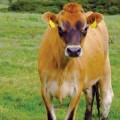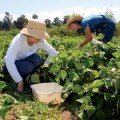I wrote a couple of weeks ago about my efforts to find a source for raw milk, and at last I’ve found one. Her name is Dahlia; she’s a doe-eyed Jersey cow with some of the sweetest, richest-tasting milk I’ve ever had.
I’ve been looking for raw milk because I’ve gotten into making my own yogurt and butter, and I want to try my hand at cheese making. Pasteurized milk is no good for that. It seems pretty clear, too, that raw milk is better for me and the cows.
Pasteurization and homogenization remove many of the nutritional benefits of milk. Raw milk goes from the cow straight to the bottle. Milk is pasteurized to remove potentially deadly pathogens. Where do the pathogens come from? Dirty dairy conditions. Pasteurization cleans up the mess. Raw milk has to be ultraclean and can’t hide behind pasteurization.
California is one of 10 states that allow the retail sale of raw milk. But buying raw milk in stores is expensive: A quart of Organic Pastures milk (one of two brands available in stores) goes for about $8. Plus it comes in a plastic container, which I try to avoid. So I set out to find a source for milk direct from a dairy. It is illegal to sell raw milk to consumers this way, and in an example of governmental intrusion at its worst, the federal government has raided several raw-milk dairies. Which is ludicrous. I don’t want to get all Ron Paul on you, but if I want to purchase milk from a dairyman that’s my business, not the government’s.
There’s a loophole around this. You can buy a “cow share,” in which a group of people share the cost of the whole animal. Once you own a cow, you can do with it what you want. So that’s what I’m doing. Once a week, I pick up four half-gallon Mason jars filled with ice-cold raw milk. There’s a four-inch layer of cream on the top of the jars tinted a pale yellow from all the fresh, rain-watered grass Dahlia is eating now.
Along with buying local and in season, one of the mantras of the good-food movement is knowing where your food comes from, something that few of us do. Isn’t that strange? We spend more time getting references for a mechanic than doing our due diligence on the stuff we put in our bodies. I know that not everyone has access to a dairy cow like I do, but I invite you to look for ways to really own the source of some of the food you eat. Start with just one or two things, like meat, vegetables or bread.
There’s real power in knowing exactly where your food came from—who produced it and how. Most of us put our trust in distant companies, but I assure you that few of these companies have your best interests in mind. What’s more, they don’t want you to know how they make the food you eat, because then you probably wouldn’t want to eat it.
But for your health and the health of the planet it really is worth knowing. And guess what? The more you know about where your food comes from the better it tastes. Come over for a glass of Dahlia’s milk, and I’ll prove it.

 Silicon Valley Cities Could Derail High-Speed Rail Plan
Silicon Valley Cities Could Derail High-Speed Rail Plan  Octobop
Octobop 


